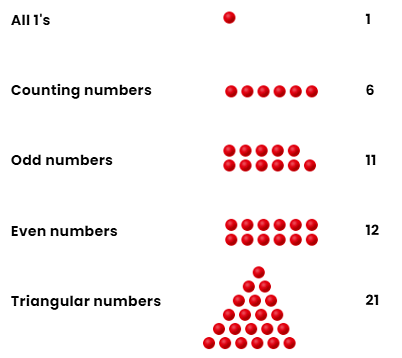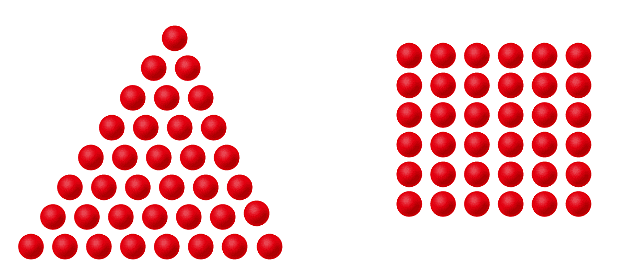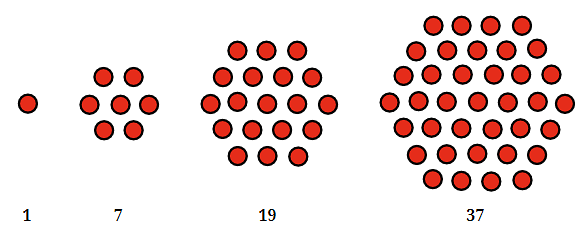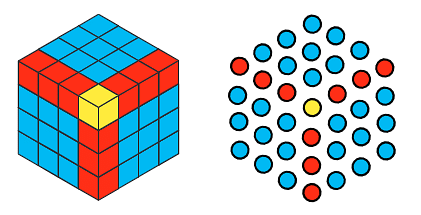Chapter 13 ped kee baat Solutions
November 5, 2024Chapter 02 Lines and Angles Solutions
November 5, 2024Chapter 01 Patterns in Mathematics Text Book Solutions
Page 2
Q1. Can you think of other examples where mathematics helps us in our everyday lives?
Ans: Students need to do this question by themselves. Here’s a sample answer for their help:
Mathematics helps in various aspects of our daily lives, such as:
- Shopping: Calculating total costs, discounts, and change.
- Cooking: Measuring ingredients and adjusting recipes.
- Construction: Designing and building structures with accurate measurements.
- Traveling: Estimating travel times and distances.
- Technology: Developing and using gadgets like computers, smartphones, and more.
Q2. How has mathematics helped propel humanity forward?
Ans: Students need to do this question by themselves. Here’s a sample answer for their help:
Mathematics has been crucial in advancing humanity in several ways:
- Scientific Experiments: It helps in creating models, analyzing data, and making predictions.
- Economy and Democracy: It aids in statistical analysis, budgeting, and economic planning.
- Engineering: Mathematics is fundamental in designing and constructing buildings, bridges, and other infrastructures.
- Technology: It is the backbone of developing and programming computers, smartphones, and other technological devices.
- Transportation: It allows for the design and optimization of vehicles, planes, trains, and more.
Page 3
Q1. Recognize the pattern in each of the sequences in Table 1.
Ans: This question needs to be answered by students themselves. Here’s an explanation for better understanding:
- All 1’s: Every number is 1.
- Counting numbers: Numbers increase by 1 each time (1, 2, 3, 4, …).
- Odd numbers: Numbers increase by 2, starting from 1 (1, 3, 5, 7, …).
- Even numbers: Numbers increase by 2, starting from 2 (2, 4, 6, 8, …).
- Triangular numbers: Each number is the sum of the first n natural numbers (1, 3, 6, 10, …).
- Squares: Each number is a square of a natural number (1, 4, 9, 16, …).
- Cubes: Each number is a cube of a natural number (1, 8, 27, 64, …).
- Virahānka numbers (Fibonacci sequence): Each number is the sum of the two preceding ones (1, 2, 3, 5, 8, …).
- Powers of 2: Each number is 2 raised to a power (1, 2, 4, 8, …).
- Powers of 3: Each number is 3 raised to a power (1, 3, 9, 27, …).
Q2. Rewrite each sequence of Table 1 in your notebook, along with the next three numbers in each sequence! After each sequence, write in your own words what is the rule for forming the numbers in the sequence.
Ans: This question needs to be answered by students themselves. Here’s a sample answer:
- All 1’s: 1, 1, 1, 1, … (The next three numbers are 1, 1, 1. The rule is that every number is 1.)
- Counting numbers: 1, 2, 3, 4, 5, 6, 7, … (The next three numbers are 8, 9, 10. The rule is to add 1 to the previous number.)
- Odd numbers: 1, 3, 5, 7, 9, 11, 13, … (The next three numbers are 15, 17, 19. The rule is to add 2 to the previous number.)
- Even numbers: 2, 4, 6, 8, 10, 12, 14, … (The next three numbers are 16, 18, 20. The rule is to add 2 to the previous number.)
- Triangular numbers: 1, 3, 6, 10, 15, 21, 28, … (The next three numbers are 36, 45, 55. The rule is to add the next natural number in sequence.)
- Squares: 1, 4, 9, 16, 25, 36, 49, … (The next three numbers are 64, 81, 100. The rule is to square the next natural number.)
- Cubes: 1, 8, 27, 64, 125, 216, … (The next three numbers are 343, 512, 729. The rule is to cube the next natural number.)
- Virahānka numbers (Fibonacci sequence): 1, 2, 3, 5, 8, 13, 21, … (The next three numbers are 34, 55, 89. The rule is to add the last two numbers.)
- Powers of 2: 1, 2, 4, 8, 16, 32, 64, … (The next three numbers are 128, 256, 512. The rule is to multiply the last number by 2.)
- Powers of 3: 1, 3, 9, 27, 81, 243, 729, … (The next three numbers are 2187, 6561, 19683. The rule is to multiply the last number by 3.)
Page 4
Q1. Copy the pictorial representations of the number sequences in Table 2 in your notebook, and draw the next picture for each sequence!
Ans: This question needs to be answered by students themselves. Here are some sample answer for better understanding:

Students need to complete this question by themselves.
Hint:
- Squares: The next picture for squares (1, 4, 9, 16, 25…) would have 36 dots arranged in a 6×6 grid.
- Cubes: The next picture for cubes (1, 8, 27, 64, 125…) would be a cube with 216 smaller cubes (6x6x6).
Q2. Why are 1, 3, 6, 10, 15, … called triangular numbers? Why are 1, 4, 9, 16, 25, … called square numbers or squares? Why are 1, 8, 27, 64, 125, … called cubes?
Ans:
- Triangular numbers: These numbers can be arranged in the shape of a triangle by placing dots in increasing rows.
- Square numbers: These numbers can be arranged in the shape of a square by placing dots in equal rows and columns.
- Cubes: These numbers can be arranged in the shape of a cube by placing dots in three-dimensional layers.
Q3. You will have noticed that 36 is both a triangular number and a square number! Make pictures in your notebook illustrating this!
Ans: This question needs to be answered by students themselves. Here’s a sample answer for better understanding:

Q4. What would you call the following sequence of numbers: 1, 7, 19, 37?

Ans: These are called hexagonal numbers because they can be arranged in a hexagon shape.
Q5. Can you think of pictorial ways to visualize the sequence of Powers of 2? Powers of 3?
Ans: Students need to do this question by themselves. Here’s a sample answer for their help:
- Powers of 2: You can visualize the powers of 2 as squares where each subsequent square has twice the number of smaller squares as the previous one.
- Powers of 3: You can visualize the powers of 3 as cubes, where each subsequent cube has three times the number of smaller cubes as the previous one.
Page 7
Q1. Can you find a similar pictorial explanation for why adding counting numbers up and down gives square numbers?
Ans: Students need to do this question by themselves. Here’s a sample answer for their help:
Imagine arranging the numbers in rows, where each row adds one more number and then subtracts one until it reaches back to 1. When these numbers are added up, they fill in the squares, forming perfect square grids.
Q2. By imagining a large version of your picture, or drawing it partially, as needed, can you see what will be the value of 1 + 2 + 3 + … + 99 + 100 + 99 + … + 3 + 2 + 1?
Ans: This question needs to be answered by students themselves. Here’s an explanation for better understanding:
When counting up to 100 and then back down, the total sum will form a square number.
Q3. What sequence do you get when you start to add the All 1’s sequence up? What sequence do you get when you add the All 1’s sequence up and down?
Ans:
- All 1’s sequence up: The result is the counting numbers (1, 2, 3, 4, …).
- All 1’s sequence up and down: The result is triangular numbers (1, 3, 6, 10, …).
Q4. What sequence do you get when you start to add the Counting numbers up? Can you give a smaller pictorial explanation?
Ans: When you start adding counting numbers, you get triangular numbers. This question needs to be answered by students themselves.
Q5. What happens when you add up pairs of consecutive triangular numbers?
Ans: Adding pairs of consecutive triangular numbers results in square numbers.
Q6. What happens when you start to add up powers of 2 starting with 1, and then add 1 to each of these numbers?
Ans: The sum of powers of 2 plus 1 results in the next power of 2, forming a new sequence of powers of 2.
Q7. What happens when you multiply the triangular numbers by 6 and add 1? Can you explain it with a picture?
Ans: Multiplying triangular numbers by 6 and adding 1 results in a new sequence.
Q8. What happens when you start to add up hexagonal numbers? take 1, 1 + 7, 1 + 7 + 19, 1 + 7 + 19 + 37, … ? Which sequence do you
get? Can you explain it using a picture of a cube?
Ans: Adding up hexagonal numbers forms a new sequence.

Q9. Find your own patterns or relations in and among the sequences in Table 1. Can you explain why they happen with a picture or otherwise?
Ans: Students need to do this question by themselves. Here’s a sample answer for their help:
Various patterns can be discovered by exploring how sequences like triangular numbers, squares, and cubes relate to each other. For example, triangular numbers added together form square numbers, and visualizing this with diagrams can help explain why this happens.
Page 10
Q1. Can you recognize the pattern in each of the sequences in Table 3?
Ans: This question encourages students to observe and identify the patterns on their own. The patterns involve the growth and arrangement of shapes, such as stacking triangles or squares and forming complete graphs. Students should recognize how each sequence evolves and increases in complexity as more shapes or connections are added.
Q2. How many little squares are there in each shape of the sequence of Stacked Squares?
Ans: The number of little squares in each shape follows the pattern of square numbers:
First shape: 1 square
Second shape: 4 squares (2×2)
Third shape: 9 squares (3×3)
Fourth shape: 16 squares (4×4)
Explanation: The number of little squares increases as the square of the number of rows or columns in the shape, following the sequence 1, 4, 9, 16, etc.
Q3. How many little triangles are there in each shape of the sequence of Stacked Triangles?
Ans: The number of little triangles in each shape follows the pattern of triangular numbers:
First shape: 1 triangle
Second shape: 3 triangles (1+2)
Third shape: 6 triangles (1+2+3)
Fourth shape: 10 triangles (1+2+3+4)
Explanation: The number of little triangles increases according to the triangular number sequence, where each shape adds another row of triangles, following the sequence 1, 3, 6, 10, etc.
Q4. How many total line segments are there in each shape of the Koch Snowflake?
Ans: The number of line segments in each shape of the Koch Snowflake increases as follows:
First shape: 3 line segments
Second shape: 12 line segments
Third shape: 48 line segments
Fourth shape: 192 line segments
Explanation: The number of line segments increases by multiplying by 4 each time. This results in the sequence 3, 12, 48, 192, which is 3 times the powers of 4 (i.e., 3 × 4^n).

